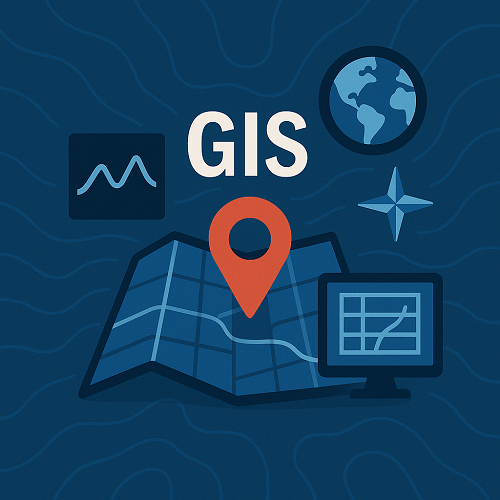TL;DR
- Remote sensing and UAVs are driving a new era of high-accuracy spatial data collection.
- Esri continues to lead the software landscape with major 2025 updates to ArcGIS tools.
- GIS-powered spatial analytics now integrate AI for predictive urban management and environmental forecasting.
- Emerging GIS applications extend beyond Earth—helping planetary mapping and space exploration missions.
- Businesses are leveraging GIS insights for smarter operations, sustainability, and strategic planning.
What’s New Right Now
Geospatial Information Systems (GIS) are experiencing a surge of innovation in 2025. The latest advancements highlight three interconnected areas: remote sensing, unmanned aerial vehicles (UAVs), and next-generation spatial analytics. Esri, the global GIS leader, continues to refine its ArcGIS platform with new AI-assisted features for geospatial modeling and cloud-based collaboration. These developments enhance real-time geodata visualization and improve accessibility across industries, from agriculture to urban planning.
Additionally, the integration of UAV data streams with GIS platforms enables near-instant topographic mapping and environmental monitoring. Paired with satellite-derived remote sensing, GIS technology is now supporting large-scale terrain analysis for climate insight and disaster response. According to NASA Earth Observatory, ongoing Earth observation initiatives feed data directly into GIS analytics for sustainable land management and policy-making.
Why It Matters
For business and technical stakeholders, GIS has become a cornerstone of spatial intelligence. Enhanced mapping accuracy translates into better resource allocation and asset management. Organizations using integrated GIS can track real-time logistics, monitor environmental risk, and optimize infrastructure projects using predictive spatial models.
Technically, new AI-powered GIS workflows reduce manual data preprocessing, improving turnaround time and decision support precision. The cloud-based delivery of GIS services also facilitates team collaboration and scalability—critical for global enterprises handling big geospatial data.
Key Trends Shaping GIS in 2025
1. Remote Sensing Gets Sharper
Advances in satellite sensor resolution and hyperspectral imaging are pushing the boundaries of surface analysis. Urban planners benefit from centimeter-level ground mapping accuracy, while conservation specialists use multi-temporal imagery to detect ecological shifts.
2. UAV Integration Gains Momentum
Unmanned Aerial Vehicles now serve as agile data capture tools for rural mapping projects. Low-altitude aerial imagery complements satellite views, offering rich 3D terrain models for rapid assessment and emergency response.
3. Spatial Analytics and Predictive Modeling
GIS analytics powered by AI can now forecast urban growth patterns and climate trends. This predictive capability drives proactive infrastructure investments and resilience planning.
| Approach | Data Source | Use Case | Update Frequency |
|---|---|---|---|
| Traditional Mapping | Survey data | Static land-use maps | Annual |
| Remote Sensing GIS | Satellite/UAV imagery | Environmental monitoring | Monthly or weekly |
| AI-Powered Spatial Analytics | Live IoT + sensor feeds | Predictive urban modeling | Real-time |
| Cloud GIS Collaboration | Multi-source repositories | Global data sharing | Continuous |
Mini Case Study: Smart Urban Drainage Optimization
Problem: A mid-sized city faced recurring flooding issues due to outdated drainage maps and uncoordinated maintenance schedules.
Approach: The municipal engineering team implemented a cloud-based GIS model combining UAV imagery and hydrology data. By integrating Esri ArcGIS analytics with live sensor inputs, they simulated rainfall flow patterns and redesigned drain networks using predictive flooding zones.
Outcome: Within six months, flood-prone intersections decreased by 40%. Maintenance operations shifted from reactive to proactive, supported by visual dashboards that track seasonal water levels. The initiative also attracted private investment into smart infrastructure projects.
Implementation Checklist
- Define spatial objectives—identify target use cases (urban planning, asset tracking, or environmental analysis).
- Select appropriate GIS software suite and cloud deployment method.
- Collect and preprocess spatial datasets from UAVs, sensors, or satellite imagery.
- Establish data governance and ensure metadata quality.
- Integrate AI-based analytics for predictive insights.
- Visualize and validate findings through dashboards and reporting tools.
- Train staff and maintain ongoing performance audits to keep GIS operations scalable.
Frequently Asked Questions
1. How is GIS different from traditional mapping?
GIS goes beyond map creation—it enables spatial analysis that reveals patterns, relationships, and predictive insights from geodata.
2. What industries benefit the most from GIS technology?
Urban planning, agriculture, logistics, environmental protection, and energy sectors rely heavily on GIS for decision-making and sustainability management.
3. Is UAV data accurate enough for professional GIS workflows?
Yes. Modern UAVs equipped with LiDAR or multispectral sensors provide centimeter-level accuracy suitable for professional-grade spatial modeling.
4. Can GIS solutions support sustainability goals?
Absolutely. GIS helps monitor carbon footprints, plan renewable energy sites, and guide climate adaptation strategies.
5. What are the biggest challenges in GIS adoption?
Data integration complexity, licensing costs, and skill gaps are common obstacles—but cloud GIS and online training are reducing these barriers.
6. How is AI changing the GIS landscape?
AI automates data classification and anomaly detection, transforming GIS into a predictive decision-support tool rather than a descriptive one.
Conclusion
As we advance through 2025, GIS stands as a cross-sector catalyst for smarter planet-scale decisions. From autonomous data capture to AI-powered modeling, spatial intelligence continues to redefine how we see and shape our world. For organizations seeking to leverage these breakthroughs, now is the time to explore our GIS services and unlock the full potential of geospatial innovation.
